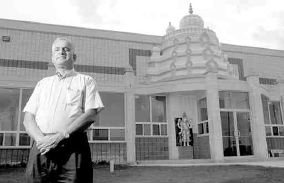
They call their Glanbrook temple Canada's Ground Zero and the passage of five years has merely intensified the peaceful battle they have waged to bring authorities on side.
Hamilton's Hindus unwittingly became the poster children for havoc and hatred when their 20 Road East temple was destroyed in an arson fire four days after terrorist planes took down the Twin Towers and crashed into the Pentagon.
Today, their newly rebuilt spiritual home represents both a triumph and an albatross: The spacious, fireproof, naturally lit sanctuary is a source of joy and pride for area Hindus -- but also a source of relentless debt.
They need another $500,000 to finish the $1.7-million structure, says temple president Ram Kamath. Two-thirds of that would retire loans while the remainder would see the last deities installed, finish the parking lot and pay for a security system.
Kamath can't understand how the province can pledge more than $16 million to the Caledonia crisis and even $1 million to the Ontario Cricket Association but won't help to rebuild the Hindu Samaj Temple. Then there's the $30 million the federal government will give to Lebanon.
"How come they don't have $500,000 to erect this community and building?" asks Kamath.
The Department of Canadian Heritage has no plans for a grant and the province's contribution thus far has been a $32,000 grant from the Trillium Foundation towards a senior's wellness centre at the temple.
His voice betrays his frustration. "It's whom you know and to which group you belong," says Kamath.
"It's not true we didn't apply for money. I was told to go the cultural department. Then they told me to go to the immigration department. I said, 'Look, my life is short, tell me which department I have to go to and I will go there. Don't give me a run-around.'"
The city, which erected a $10,000 parkette in front of the temple, is limited in what it can can fund on private property, says Mayor Larry Di Ianni.
"I'm not going to refute or corroborate that they are Canada's Ground Zero," he adds. "But it was a traumatic experience that brought home to our community how the madness of international events can hurt good and innocent people."
Narendar Passi, temple president at the time of the arson, sometimes wonders if it was a blessing in disguise. The old building -- a former church -- was never big enough for the city's growing Hindu community, he says.
"But the shock and the work that we had to do to bring it back to life, I would not wish on anybody," Passi says.
Meanwhile, police continue to probe the arson. The case against a Hamilton man charged with arson fell apart in court almost four years ago. The Crown withdrew charges, citing a lack of physical evidence and a credibility issue with the lone witness.
Superintendent Glyn Wide says that the passage of time will only help with the evolution of a new investigative technique or new information from a witness whose life has changed and is now willing to talk.
"I'm confident we're looking in the right area," Wide says.
For Madina Wasuge, newly appointed executive director of the Centre for Civic Inclusion, the temple is a potent symbol of a place that was violated by hatred but then rebuilt by a community that pulled together.
The centre's very roots lie in the temple's destruction countered by the community's solidarity in battling racism. So Wasuge sympathizes with the notion that the temple is Canada's Ground Zero.
But she says the $500,000 funding shortfall should be taken up as yet another exercise in community building and intolerance busting.
"We shouldn't just rely on government," she says. "As a community, we need to come together and fundraise and challenge ourselves to raise a certain amount and then ask the levels of government to match that.
"And not just the Hindu community but the whole community. We have to heal this wound together."

No comments:
Post a Comment